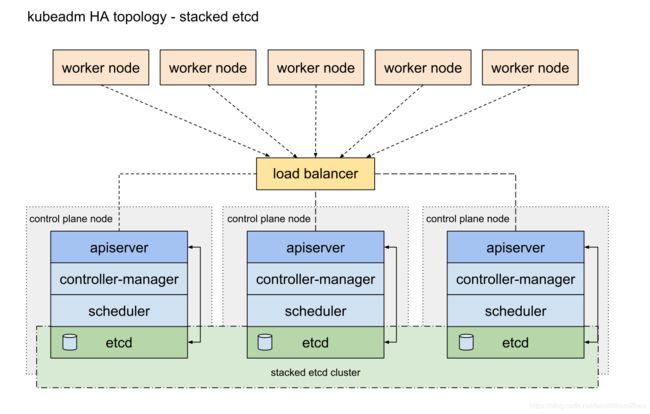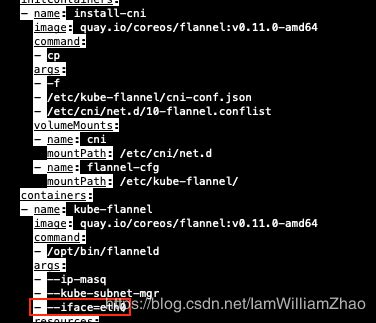How to setup a high available Kubernetes cluster with v1.15.0
Kubernetes is the best platform for hosting cloud-native applications, there are several topologies for a Kubernetes cluster, if you are going to deploy many applications into one cluster in a production environment, then you might need a high available Kubernetes cluster, in this article, I describe how to setup a HA cluster with local stacked etcd server. here is the diagram:

environments
there should be at least 3 master nodes, one load balance node for api-server, and many worker nodes( if you want to persistent some data into file storage, you might need a node for NFS server).
1: redhat linux:
cat /proc/version
Linux version 3.10.0-957.21.3.el7.x86_64 ([email protected]) (gcc version 4.8.5 20150623 (Red Hat 4.8.5-36) (GCC) ) #1 SMP Fri Jun 14 02:54:29 EDT 2019
2: docker Version:
docker version
Client:
Version: 18.09.6
API version: 1.39
Go version: go1.10.8
Git commit: 481bc77156
Built: Sat May 4 02:34:58 2019
OS/Arch: linux/amd64
Experimental: false
Server: Docker Engine - Community
Engine:
Version: 18.09.6
API version: 1.39 (minimum version 1.12)
Go version: go1.10.8
Git commit: 481bc77
Built: Sat May 4 02:02:43 2019
OS/Arch: linux/amd64
Experimental: false
3: Kubernetes version:
kubeadm version: &version.Info{Major:"1", Minor:"15", GitVersion:"v1.15.0",
GitCommit:"e8462b5b5dc2584fdcd18e6bcfe9f1e4d970a529", GitTreeState:"clean", BuildDate:"2019-06-19T16:37:41Z",
GoVersion:"go1.12.5", Compiler:"gc", Platform:"linux/amd64"}
kubectl version
Client Version: version.Info{Major:"1", Minor:"15", GitVersion:"v1.15.0", GitCommit:"e8462b5b5dc2584fdcd18e6bcfe9f1e4d970a529",
GitTreeState:"clean", BuildDate:"2019-06-19T16:40:16Z", GoVersion:"go1.12.5", Compiler:"gc", Platform:"linux/amd64"}
Server Version: version.Info{Major:"1", Minor:"15", GitVersion:"v1.15.0", GitCommit:"e8462b5b5dc2584fdcd18e6bcfe9f1e4d970a529",
GitTreeState:"clean", BuildDate:"2019-06-19T16:32:14Z", GoVersion:"go1.12.5", Compiler:"gc", Platform:"linux/amd64"}
kubelet --version
Kubernetes v1.15.0
prepare environment
all below steps need to be executed on all master nodes and worker nodes
disable selinux
systemctl stop selinux
vi /etc/sysconfig/selinux

disable swap
swapoff -a
vi /etc/fstab
comment out swap entry in stab with char #

disable firewalld
I do not have much time to figure out how to enable firewalld to work well with Kubernetes, so here I disable and stop firewalld with following command:
systemctl disable firewalld
systemctl stop firewalld
install and enable iptable
yum install -y iptables
yum install -y iptables-services
systemctl enable iptables
systemctl start iptables
configure iptable
we need to open following firewall ports for Kubernetes
iptables -A INPUT -p tcp --sport 22 -j ACCEPT
iptables -A INPUT -p tcp --sport 80 -j ACCEPT
iptables -A INPUT -p tcp --sport 443 -j ACCEPT
iptables -A INPUT -p tcp --sport 2049 -j ACCEPT ---->this is for NFS
iptables -A INPUT -p tcp --sport 9443 -j ACCEPT ---->this is for api server proxy
iptables -A INPUT -p tcp --sport 6443 -j ACCEPT
iptables -A INPUT -p tcp --sport 2379:2380 -j ACCEPT
iptables -A INPUT -p tcp --sport 10248 -j ACCEPT
iptables -A INPUT -p tcp --sport 10250:10254 -j ACCEPT
iptables -A INPUT -p tcp --sport 30000:32767 -j ACCEPT
iptables -A OUTPUT -p tcp --dport 22 -j ACCEPT
iptables -A OUTPUT -p tcp --dport 80 -j ACCEPT
iptables -A OUTPUT -p tcp --dport 443 -j ACCEPT
iptables -A OUTPUT -p tcp --dport 2049 -j ACCEPT
iptables -A OUTPUT -p tcp --dport 9443 -j ACCEPT
iptables -A OUTPUT -p tcp --dport 6443 -j ACCEPT
iptables -A OUTPUT -p tcp --dport 2379:2380 -j ACCEPT
iptables -A OUTPUT -p tcp --dport 10248 -j ACCEPT
iptables -A OUTPUT -p tcp --dport 10250:10254 -j ACCEPT
iptables -A OUTPUT -p tcp --dport 30000:32767 -j ACCEPT
service iptables save
systemctl restart iptables
install and enable docker version CE-18.09.06
yum -y install https://download.docker.com/linux/centos/7/x86_64/stable/Packages/docker-ce-cli-18.09.6-3.el7.x86_64.rpm
yum -y install https://download.docker.com/linux/centos/7/x86_64/stable/Packages/containerd.io-1.2.5-3.1.el7.x86_64.rpm
yum -y install http://mirror.centos.org/centos/7/extras/x86_64/Packages/container-selinux-2.107-1.el7_6.noarch.rpm
yum -y install https://download.docker.com/linux/centos/7/x86_64/stable/Packages/docker-ce-18.09.6-3.el7.x86_64.rpm
systemctl enable docker
systemctl start docker
install kubernetes and enable kubelet
enable kubernetes repository for yum
cat < /etc/yum.repos.d/kubernetes.repo
[kubernetes]
name=Kubernetes
baseurl=https://packages.cloud.google.com/yum/repos/kubernetes-el7-x86_64
enabled=1
gpgcheck=1
repo_gpgcheck=1
gpgkey=https://packages.cloud.google.com/yum/doc/yum-key.gpg https://packages.cloud.google.com/yum/doc/rpm-package-key.gpg
exclude=kube*
EOF
install kubernetes
yum install -y kubelet kubeadm kubectl --disableexcludes=kubernetes
enable kubelet
systemctl enable kubelet
systemctl start kubelet
enable net bridge for K8s
cat < /etc/sysctl.d/k8s.conf
net.bridge.bridge-nf-call-ip6tables = 1
net.bridge.bridge-nf-call-iptables = 1
EOF
sysctl -p /etc/sysctl.d/k8s.conf
all above steps are needed on all nodes, after all these steps are done, then we can focus on following steps.
install and configure nginx
In a HA cluster, there should be one web server to do load balance for kube-api-servers, in Kubernetes official documents, HAProxy is recommended, but since I am more familiar with nginx, so here I setup ngnix to work as the load balancer.
Install nginx on your web server node
Config yum repository for nginx:
cat < /etc/yum.repos.d/nginx.repo
[nginx]
name=nginx repo
baseurl=http://nginx.org/packages/mainline/rhel/7/$basearch/
gpgcheck=0
enabled=1
EOF
yum install -y nginx
systemctl enable nginx
vi /etc/nginx/nginx.conf
user nginx;
worker_processes auto;
error_log /var/log/nginx/error.log warn;
pid /var/run/nginx.pid;
worker_rlimit_nofile 65535;
events {
use epoll;
worker_connections 65535;
}
#here I use stream module to do the load balancer, if you want to use http module,
#then you need to pay attention on https certs
stream {
upstream api_server {
server dpydalpd0101.sl.xxx.xxx.com:6443 max_fails=1 fail_timeout=10s;
server dpydalpd0201.sl.xxx.xxx.com:6443 max_fails=1 fail_timeout=10s;
server dpydalpd0301.sl.xxx.xxx.com:6443 max_fails=1 fail_timeout=10s;
}
server {
listen 0.0.0.0:9443;
proxy_pass api_server;
proxy_timeout 60s;
proxy_connect_timeout 5s;
}
}
#start nginx
nginx
write cluster configuration file
we need to first prepare a cluster configuration yaml file, then use kubeadm command to initial first master node.
following is a sample configuration file:
apiVersion: kubeadm.k8s.io/v1beta2
kind: InitConfiguration
bootstrapTokens:
- token: "9a08jv.c0izixklcxtmnze7"
description: "kubeadm bootstrap token"
ttl: "24h"
- token: "783bde.3f89s0fje9f38fhf"
description: "another bootstrap token"
usages:
- authentication
- signing
groups:
- system:bootstrappers:kubeadm:default-node-token
nodeRegistration:
name: "ppydalbik0102.sl.xxx.xxx.com"
criSocket: "/var/run/dockershim.sock"
taints:
- key: "kubeadmNode"
value: "master"
effect: "NoSchedule"
localAPIEndpoint:
advertiseAddress: "10.xxx.xxx.249"
bindPort: 6443
---
apiVersion: kubeadm.k8s.io/v1beta2
kind: ClusterConfiguration
certificatesDir: "/etc/kubernetes/pki"
imageRepository: "k8s.gcr.io"
useHyperKubeImage: false
clusterName: "k8s-cluster-bi"
networking:
serviceSubnet: "172.17.0.0/16"
podSubnet: "10.244.0.0/16"
dnsDomain: "cluster.local"
kubernetesVersion: "v1.15.0"
controlPlaneEndpoint: "ppydalbik0101.sl.xxx.xxx.com:9443"
etcd:
# one of local or external
local:
imageRepository: "k8s.gcr.io"
imageTag: "3.2.24"
dataDir: "/var/lib/etcd"
serverCertSANs:
- "10.xxx.xxx.216"
- "ppydalbik0101.sl.xxx.xxx.com"
- "10.xxx.xxx.249"
- "ppydalbik0102.sl.xxx.xxx.com"
- "10.xxx.xxx.218"
- "ppydalbik0103.sl.xxx.xxx.com"
- "10.xxx.xxx.223"
- "ppydalbik0104.sl.xxx.xxx.com"
peerCertSANs:
- "10.xxx.xxx216"
- "ppydalbik0101.sl.xxx.xxx.com"
- "10.xxx.xxx.249"
- "ppydalbik0102.sl.xxx.xxx.com"
- "10.xxx.xxx.218"
- "ppydalbik0103.sl.xxx.xxx.ibm.com"
- "10.xxx.xxx.223"
- "ppydalbik0104.sl.xxx.xxx.com"
apiServer:
extraArgs:
authorization-mode: "Node,RBAC"
apiserver-count: "3"
certSANs:
- "10.xxx.xxx.216"
- "ppydalbik0101.sl.xxx.xxx.com"
- "10.xxx.xxx.249"
- "ppydalbik0102.sl.xxx.xxx.com"
- "10.xxx.xxx.218"
- "ppydalbik0103.sl.xxx.xxx.com"
- "10.xxx.xxx.223"
- "ppydalbik0104.sl.xxx.xxx.com"
timeoutForControlPlane: 4m0s
---
apiVersion: kubelet.config.k8s.io/v1beta1
kind: KubeletConfiguration
# kubelet specific options here
---
apiVersion: kubeproxy.config.k8s.io/v1alpha1
kind: KubeProxyConfiguration
#kube-proxy specific options here
then you can use following command to initial your cluster
kubeadm init --config=/etc/kubernetes/k8s-cluster-bi.yaml --upload-certs
if you successfully initialize your cluster, then you will see following information
Your Kubernetes control-plane has initialized successfully!
To start using your cluster, you need to run the following as a regular user:
mkdir -p $HOME/.kube
sudo cp -i /etc/kubernetes/admin.conf $HOME/.kube/config
sudo chown $(id -u):$(id -g) $HOME/.kube/config
You should now deploy a pod network to the cluster.
Run "kubectl apply -f [podnetwork].yaml" with one of the options listed at:
https://kubernetes.io/docs/concepts/cluster-administration/addons/
You can now join any number of the control-plane node running the following command on each as root:
kubeadm join ppydalbik0101.sl.xxx.xxx.com:9443 --token 7396yd.ngzodxtroc7qcs7n \
--discovery-token-ca-cert-hash sha256:50d65683cc9cd7c1e375fb92eaa5578ed8ec970bd712ba3afb1336eaca8127ed \
--experimental-control-plane --certificate-key 8681021d49f6dfeefa35e026d8d827cec0b3d7e2a1ce1f9f8fea458f036e7b88
Please note that the certificate-key gives access to cluster sensitive data, keep it secret!
As a safeguard, uploaded-certs will be deleted in two hours; If necessary, you can use
"kubeadm init phase upload-certs --upload-certs" to reload certs afterward.
Then you can join any number of worker nodes by running the following on each as root:
kubeadm join ppydalbik0101.sl.xxx.xxx.com:9443 --token 7396yd.ngzodxtroc7qcs7n \
--discovery-token-ca-cert-hash sha256:50d65683cc9cd7c1e375fb92eaa5578ed8ec970bd712ba3afb1336eaca8127ed
configure regular user to access your cluster with admin access.
mkdir -p $HOME/.kube
sudo cp -i /etc/kubernetes/admin.conf $HOME/.kube/config
sudo chown $(id -u):$(id -g) $HOME/.kube/config
install network add on
get flannel deployment file
curl https://raw.githubusercontent.com/coreos/flannel/master/Documentation/kube-flannel.yml > kube-flannel.yml
get your ethernet adapter with command ifconfig

edit flannel deployment file

Add flannel network add-on:
kubectl apply -f kube-flannel.yml
podsecuritypolicy.extensions/psp.flannel.unprivileged created
clusterrole.rbac.authorization.k8s.io/flannel created
clusterrolebinding.rbac.authorization.k8s.io/flannel created
serviceaccount/flannel created
configmap/kube-flannel-cfg created
daemonset.extensions/kube-flannel-ds-amd64 created
daemonset.extensions/kube-flannel-ds-arm64 created
daemonset.extensions/kube-flannel-ds-arm created
daemonset.extensions/kube-flannel-ds-ppc64le created
daemonset.extensions/kube-flannel-ds-s390x created
join other cluster master nodes
kubeadm join ppydalbik0101.sl.xxx.xxx.com:9443 --token 7396yd.ngzodxtroc7qcs7n --discovery-token-ca-cert-hash sha256:50d65683cc9cd7c1e375fb92eaa5578ed8ec970bd712ba3afb1336eaca8127ed --experimental-control-plane --certificate-key 8681021d49f6dfeefa35e026d8d827cec0b3d7e2a1ce1f9f8fea458f036e7b88
join worker nodes
kubeadm join ppydalbik0101.sl.xxx.xxx.com:9443 --token 7396yd.ngzodxtroc7qcs7n --discovery-token-ca-cert-hash sha256:50d65683cc9cd7c1e375fb92eaa5578ed8ec970bd712ba3afb1336eaca8127ed
after join nodes, sometimes we need to refresh iptables
systemctl daemon-reload
systemctl stop kubelet
systemctl stop docker
iptables --flush --be careful on this, this will remove your firewall settings.
iptables -tnat --flush. --after flush steps, you need to list and check if your rules are there, of you need to set your rules again
systemctl start kubelet
systemctl start docker
service iptables save
systemctl restart iptables
install and configure nfs (this step is not necessary, but its useful, so I write this step here)
when you move your applications into docker, you need to consider where and how to persistent some data(files), for example, you can use a database to store some structure data, you can save some files into some storage such Object storage or File storage, when you setup a Kubernetes cluster manually, we can use a NFS server to work as a file storage, its very easy to setup and configure.
open firewall ports for nfs-server:
if you use iptables, then you can use follow commands to open firewall ports on your nfs server node
iptables -A INPUT -p tcp --dport 111 -j ACCEPT
iptables -A INPUT -p udp --dport 111 -j ACCEPT
iptables -A INPUT -p tcp --dport 20048 -j ACCEPT
iptables -A INPUT -p udp --dport 20048 -j ACCEPT
iptables -A INPUT -p tcp --dport 2049 -j ACCEPT
iptables -A INPUT -p udp --dport 2049 -j ACCEPT
iptables -A OUTPUT -p tcp --sport 111 -j ACCEPT
iptables -A OUTPUT -p udp --sport 111 -j ACCEPT
iptables -A OUTPUT -p tcp --sport 2049 -j ACCEPT
iptables -A OUTPUT -p udp --sport 2049 -j ACCEPT
iptables -A OUTPUT -p tcp --sport 20048 -j ACCEPT
iptables -A OUTPUT -p udp --sport 20048 -j ACCEPT
if you use firewall, you can use following command to open your firewall ports on nfs-server node:
systemctl enable firewalld
systemctl start firewalld
firewall-cmd --zone=public --permanent --add-port=111/tcp
firewall-cmd --zone=public --permanent --add-port=111/udp
firewall-cmd --zone=public --permanent --add-port=2049/tcp
firewall-cmd --zone=public --permanent --add-port=2049/udp
firewall-cmd --zone=public --permanent --add-port=20048/tcp
firewall-cmd --zone=public --permanent --add-port=20048/udp
firewall-cmd --permanent --add-service=mountd
firewall-cmd --permanent --add-service=nfs
firewall-cmd --permanent --add-service=rpc-bind
firewall-cmd --reload
systemctl restart firewalld
install nfs server:
yum install -y rpcbind nfs-utils
enable and start nfs server:
systemctl enable nfs-server
systemctl start nfs-server
configure nfs-server:
vi /etc/exports
/data/disk1 *.xxx.com (rw,no_root_squash,no_all_squash,sync)
restart nfs-server:
systemctl restart nfs-server
check mount on nfs-server node:
showmount -e localhost
Export list for localhost:
/data/disk1 *
since we have opened firewall ports on all the master and worker nodes,
so now you can directly create PV/PVC to use file system on this nfs-server,
if you want to mount the file system on this nfs-server on other VMs,
you can following steps to install nfs client and create a mount.
1) you need to open firewall port 2049 on nfs client node:
iptables -A INPUT -p tcp --sport 2049 -j ACCEPT
iptables -A OUTPUT -p tcp --dport 2049 -j ACCEPT
2) install nfs-utils:
yum install -y nfs-utils
3) check nfs-server:
showmount -e nfs-server-ip-address
Export list for 10.208.1xx.xxx:
/data/disk1 *
4) create mount point
mkdir /web
5) mount file system
mount 10.208.1xx.xxx:/data/disk1 /web
6) change fstab to save this mount
vi /etc/fstab ---->add following entry
10.208.1xx.xxx:/data/disk1 /web nfs defaults 0 0